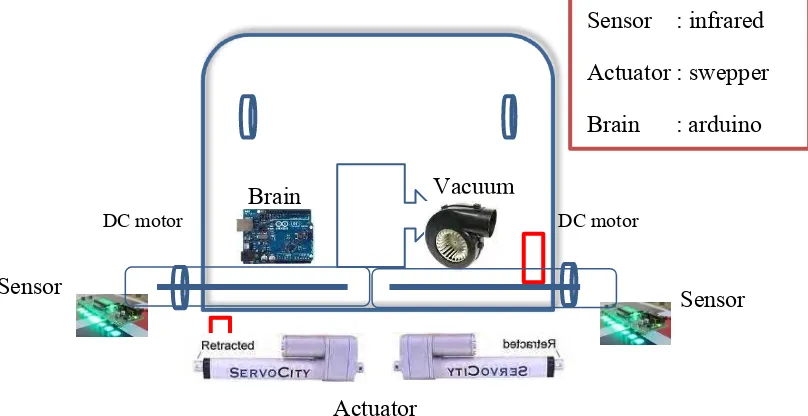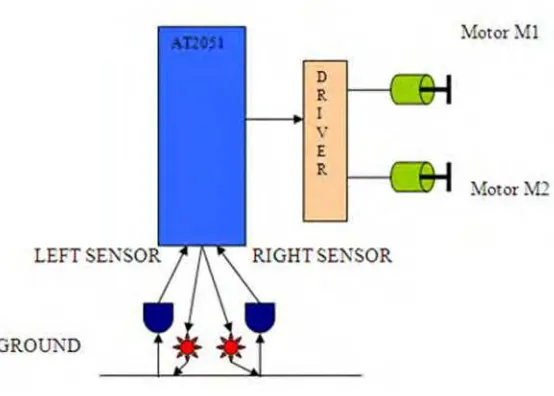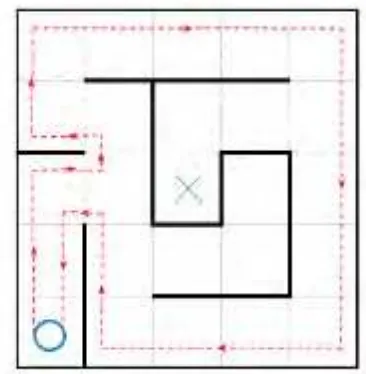UNIVERSITI TEKNIKAL MALAYSIA MELAKA
DESIGN AND DEVELOPMENT OF AUTONOMOUS SWEEPER
ROBOT FOR BADMINTON COURT
This report submitted in accordance with requirement of the Universiti Teknikal Malaysia Melaka (UTeM) for the Bachelor Degree of Engineering Technology
(Electrical Engineering Automation Industry & Robotic) with Honours
by
MOHD FAHMI BIN TAHER B071210388
910920-04-5387
UNIVERSITI TEKNIKAL MALAYSIA MELAKA
BORANG PENGESAHAN STATUS LAPORAN PROJEK SARJANA MUDA
TAJUK: DESIGN AND DEVELOPMENT OF AUTONOMOUS SWEEPER ROBOT FOR BADMINTON COURT
SESI PENGAJIAN: 2015/16 Semester 1
Saya MOHD FAHMI BIN TAHER
mengaku membenarkan Laporan PSM ini disimpan di Perpustakaan Universiti Teknikal Malaysia Melaka (UTeM) dengan syarat-syarat kegunaan seperti berikut:
1. Laporan PSM adalah hak milik Universiti Teknikal Malaysia Melaka dan penulis. 2. Perpustakaan Universiti Teknikal Malaysia Melaka dibenarkan membuat salinan
untuk tujuan pengajian sahaja dengan izin penulis.
3. Perpustakaan dibenarkan membuat salinan laporan PSM ini sebagai bahan pertukaran antara institusi pengajian tinggi.
4. **Sila tandakan ( )
SULIT
TERHAD
TIDAK TERHAD
(Mengandungi maklumat yang berdarjah keselamatan atau kepentingan Malaysia sebagaimana yang termaktub dalam AKTA RAHSIA RASMI 1972)
(Mengandungi maklumat TERHAD yang telah ditentukan oleh organisasi/badan di mana penyelidikan dijalankan)
ii
DECLARATION
I hereby, declared this report entitled “DESIGN AND DEVELOPMENT OF AUTONOMOUS SWEEPER ROBOT FOR BADMINTON COURT” is the results of my
own research except as cited in references.
Signature : ………..
Name : MOHD FAHMI BIN TAHER
iii
APPROVAL
This report is submitted to the Faculty of Engineering Technology of UTeM as a partial fulfillment of the requirements for the degree of Bachelor of Engineering Technology (Electrical Engineering Automation Industry & Robotic) with honours. The member of the supervisory is as follow:
Signature : ………
Name : MOHAMAD HANIFF BIN HARUN
iv
ABSTRACT
v
ABSTRAK
vi
DEDICATIONS
To my beloved father, Taher bin Yaakop and
mother Faridah binti Selamat
vii
ACKNOWLEDGMENTS
viii
TABLE OF CONTENTS ... viii
LIST OF FIGURES ... xi Description of prototype ... 5
ix
2.1.3 Wall follow algorithm ... 11
Previous Vacuum cleaner robot ... 11
2.2 2.2.1 Rob vac ... 12
2.2.2 Autonomous floor-cleaning robot ... 12
2.2.3 Home Mess-Clean-up Robot ... 13
Wheel to control cleaning robot ... 13
2.3 Project Methodology for overall system ... 19
3.1 3.1.1 Vacuum system ... 19
3.1.2 Actuator ... 21
3.1.3 Infrared (line follower) ... 22
3.1.4 Jetway concept ... 23
3.1.5 DC motor ... 24
x
3.1.7 Power Supply ... 25
3.1.8 Micro Fibre ... 25
3.1.9 Type of floor ... 26
Method in development of whole system ... 28
3.2 3.2.1 Project Literature & Problem Statement ... 29
3.2.2 Building Schematic Diagram... 29
3.2.3 Find the part ... 29
3.2.4 Review & Identify Functionality Of part ... 30
3.2.5 Circuit Simulation ... 30
3.2.6 Documentation ... 30
3.2.7 Designing Hardware ... 30
Process control ... 32
3.3 CHAPTER 4 ... 33
Introduction ... 33
4.0 Result and Discussion ... 38
4.1 CHAPTER 5 ... 48
Introduction ... 48
5.0 Summary of Research ... 48
5.1 Achievement of objective ... 49
xi
LIST OF FIGURES
Figure 1.1 : overview robot during off ... 2
Figure 1.2 : overview robot during on ... 2
Figure 2.1.1: infrared sensor ... 10
Figure 2.2.1: wall follow algorithm ... 11
Figure 2.3: DC motor with Gear ... 15
Figure 2.4 : Arduino mega ... 18
Figure 3.1: vacuum concept... 20
Figure 3.2: Actuator part ... 22
Figure 3.3: Infrared line follower ... 23
Figure 3.4: jetway ... 23
Figure 3.5: DC motor ... 24
Figure 3.6: Gear box ... 24
Figure 3.7 : Compare between microfiber cloth (a) and cotton cloth (b) ... 25
Figure 3.8 : PVC/PU court type... 26
Figure 3.9 : wooden board ... 27
Figure 3.10: Flow Chart ... 28
Figure 3.11 : Matlab 2010 software... 31
Figure 3.12 : process control ... 32
Figure 4.1 : Setup Arduino Mega At Robot ... 33
Figure 4.2 : Setup Arduino Mega At Robot ... 34
Figure 4.1 : Setup Arduino Mega At Robot ... 34
Figure 4.1 : Setup Arduino Mega At Robot ... 35
Figure 4.1 : Setup Arduino Mega At Robot ... 35
Figure 4.1 : Setup Arduino Mega At Robot ... 36
Figure 4.1 : Setup Arduino Mega At Robot ... 36
Figure 4.1 : Setup Arduino Mega At Robot ... 37
Figure 4.1 : Setup Arduino Mega At Robot ... 37
Figure 4.1: Voltage vs time for each device ... 39
Figure 4.2: current vs time for each device ... 39
Figure 4.3: time vs current for total project ... 40
Figure 4.4: Simulation software ... 41
Figure 4.5: clean condition ... 42
Figure 4.6: put the dust at table ... 42
xii
LIST OF TABLE
1
CHAPTER 1
INTRODUCTION
Introduction 1.0
This chapter provides an introduction about this project. It starts with general information and background about autonomous robot, problem statement and it also cover the objective, problem statement and scope for the project.
Background 1.1
Our new innovation is based on basic vacuum cleaning and robot movement. Those concerned with the design of an autonomous sweeper robot for a badminton court by using Arduino as controller. It constitutes a smooth movement, silent and easy to use. With this reason, this idea have been developed an autonomous sweeper robot for badminton court which is designed to clean a badminton court by using a basic principal of vacuum, the Arduino system as an operating system, a line follows and basic linear motion as an arm for clean. Basically, this autonomous sweeper robot f move along the line guided by line at badminton court. This project also used a motor driver to drive a motor vacuum and arm robot.
2 Project overview
1.2
Autonomous sweeper robot for badminton court construction can be divided into four main parts. There are brain, actuator, sensor and vacuum. Figure 1.1 and Figure 1.2 below shows the overview of the system inside the autonomous sweeper robot.
Figure 1.1 : overview robot during off
3 court’s floor from dust and other dirts, besides, it also polishes the floor to make it clean, smoth surface and shiny. In general, this Vacuum robot is commonly used in the vacuum chambers for handling work pieces such as semiconductor wafers, and other types of work. The vacuum robot motions require high-accuracy and high-speed without concerning the process.
The main problem is how to create fast and precise motions with the reduction of residual vibration. In many industrial robots, the method for point-to-point motion profile which called as trapezoidal velocity profile is widely used for its fast motion. However, sudden changes in the acceleration will cause a large force to excite residual vibrations. As a modified form, s-curve velocity profile is proposed to reduce residual vibrations. In recent years, the symmetric s-curve velocity profiles have been widely used in motion control fields the research gave a method to estimate the ramp-up and the ramp-down time to improve the kinematics and dynamic performance of a vacuum.
Based on previous research, vacuum cleaner robot is the length of the flow channel between the inlet of the rolling brush blower and the outlet of the vacuum blower. To cope with the pressure drop problem of the duct flow field in a robot vacuum cleaner, a method based on Pressure Implicit with Splitting of Operators (PRISO) algorithm is introduced and the optimal design of the duct flow field is implemented. Firstly, the duct structure in a robot vacuum cleaner is taken as a research object, with the computational fluid dynamics (CFD) theories adopted, that are three‐dimensional fluid model of the duct is established by means of the FLUENT solver of the CFD software.
4
investigation of the dynamic characteristics of the duct flow field is done and defects of the original duct flow field are analysed, the optimization of the original flow field has then been conducted.
Experimental results show that the duct flow field after optimization can effectively reduce pressure drop, the feasibility as well as the correctness of the theoretical modelling and optimization approaches are validated.
Problem Statement 1.4
In today’s the are increasing number of badminton players among all level of ages, genders and they come from professionals and beginners . As we know, badminton is one of the popular sports in Asia especially in Malaysia. From this, we can relate it with the research problem. One of the problems is when there are many players use the same courts every day, or sometimes the courts receive non-stop players in one day, there will be some problems faced by the players while performing the game. Many badminton players complained about the quality of the floors at badminton courts they went. As we know the quality of the floor is very important. This is because if the floor is sticked with much dust and dirts, there will be less attractive and less effective game perfomed by badminton players. In addition, slippy floor will let them to frequently fall down and injured. This is due to low pressure of shoes’ grip on the floor’s surface area.
We can see other applications that use robot as a cleaner for example, mobile vacuum robot for home application, vacuum robot for bowling lane floor and many others. However, we do not have robot to cleaner for a badminton court, or it is difficult to have that kind of robot.
5
vacuum consumes higher rate of electricity compared to vacuum cleaner robot. With the new technology, this innovation is made with lower electricity usage when it is operating
In order to solve the problems, the product have to be created. This project have been designed call as autonomous sweeper robot that able to clean and polish a badminton floor as the substitute of manual vacuum that use man power besides it is more practical and effective for users. Autonomous sweeper robot for badminton court is powered by batteries and user friendly.
Description of prototype 1.5
Vacuum concept
Production of vacuum according to developing an own mobile vacuum to clean a dust and other dirt’s
Rechargeble
This product is powered by batteries. It can be recharge when the batteries are week.
Portability
Easy to carry whenever the users go and use this product.
Objective 1.6
This product is used as a vacuum, dc motor and robot arm. Its concept is almost the similar like mobile vacuum robot but has been simplify to be use at badminton court, portable and rechargeable. The objective of this product is:
To design a mobile vacuum robot system suitable for clean badminton court To analyse and evaluate the electrical performance of this robot
6 Scope
1.7
To accomplish this project in order to work successfully, thre are a few things defined in the scopes of the project. There are :
The project using arduino microcontroller to achieve the automation. The arduino microcontroller will control a motor and receive the signal from a sensor.
Vacuum robot at badminton court with diffrent floor
Test the speed of vacuum and the swepper
Thesis outline 1.8
This project thesis is done basically to document the activities, outcome and concept of the project that is relevant to the project progress. The thesis consists of three main chapters for PSM 1. There are:
Chapter 1
Describes briefly about the project’s introduction and also discuss about the objectives, scopes of project and project application.
Chapter 2
Describes about the literature review regarding background of the project and at the same times describes about the same projects that have been done of previous person and it’s more to make research on different, advantages and disadvantages of previous project
Chapter 3
Describes about the project planning where the project implementation will be divided into three phase. There are hardware, design software and electrical part. This chapter also discusses more detail about the principal of component that will be used in the project such as infrared sensor and actuator.
7
At this chapter will be discussing about the result and analysis. This chapter will get the truth data and do recorded to discuss. From this chapter, the analysis can be define between successful or fail.
Chapter 5
8
CHAPTER 2
LITERATURE REVIEW
Introduction 2.0
This chapter informs us all about the research before the robot has been set up. To build this project, it requires the knowledge that are not readily offhand. There are three main parts need to be investigated in this project is part of robot, sensing technology and microcontroller specification. Motor is one of the methods for creating of the electronic device movement. Motors are the most importance parts of mobile robotics platform. Moreover, a sensor is a device which detects a signal on lines at badminton court. The main objective of incorporating sensors technology in robotics system is to enable the robots to move follow the line at badminton court
Movement of robot 2.1
To achieve the movement of robot system, one of the study is based on literature review, which will be discussed in detail in this chapter. For the movement of robot, research more on line follower concept, infrared, mapping and Algorithm.
2.1.1 Infrared
9
line follower robot, providing some real time data of the robot and giving the preliminary steps on fabricating a line follower robot.
This robot is the basic form of the line follower robots. Much more complex form of line following robot can be manufactured depending on this basic form of line follower robot. More specifically, efforts have been put on acquiring data during test runs so that robots can be manufactured in massive way under specific requirements of purpose
The line follower is a kind of robotic vehicle which has the capability of following a line of specific colour and it may include other functions as well. From previous study, (Pakdaman and Sanaatiyan, 2009) The robots simply sense the line by measuring light intensity (converting it into voltage) reflected from the ground, where it is assumed that an ideal black floor reflects no light and the white line reflects almost the total incident light back. The main task is sensing the line and bounding the robot to stay over the line, by continuously changing the wrong moves using an efficient program through microcontroller to achieve an optimum velocity for racing with time. The program is based on the characteristic of the light reflected by the different colour of the path. Microcontroller receives the analogue signal of reflected light as a voltage relative to the colour of the path and the voltage difference for different colour ensures the correct way to go and loaded program commands the robot to go that way automatically.
According to(Chen and Song, 2005), infrared sensor, the most common sensors for a line following robot have been LDR (Light Dependent Resistor) and IR (infrared) LED (light emitting diode). But the IR LED is the most optimized sensor for line following robot. It comprises of IR-transmitter (Tx) and receiver (Rx). This special purpose LED transmits infrared rays of wave length 760 nm. These LEDs are made of gallium arsenide or aluminium gallium arsenide.
10
it can be used to pick up object where we cannot go. Figure 2.1 below shows the infrared send the line.
Figure 2.1.1: infrared sensor
2.1.2 Path mapping
Path mapping and finding the desired path for a mobile cleaning robot in order to perform cleaning efficiently is a difficult task. In paper of (Uddin et al., 2011), in complex indoor environments, avoiding collision with other furniture or equipment is a big problem for mobile cleaning robot. In the case wireless control link should be robust for accurate moving along the desired path. But wireless radio frequency is experienced interference created by surrounding RF devices. In this paper we propose a cleaning robot control scheme using LED-ID network as a new paradigm in the in the mobile cleaning robot application. LED-ID system uses LED and visible light as a transmission source and transmission medium respectively. Therefore control the cleaning robot and illumination both are possible simultaneously. Also other radio frequency cannot interfere with the visible light. This system allows the user to teach the robot a user preferred cleaning path and provides long time cleaning stability. We also show simulation results to prove our algorithm.
11
paper we considered only one robot. (Hofner and Schmidt, 1994) The idea behind the proposed scheme is to control movement along user defined path and clean the desired area using green and existing home network. The simulation results show that the cleaning robot can move along desired path using LED-ID network with certain condition and clean up. The performance of the moving control still needs further improvement.
2.1.3 Wall follow algorithm
Wall follower algorithm has direct decision making in maze travel path. It will keep either right of left hand on wall and walk through maze without removing hand from wall. By the way, this type of algorithm cannot find end point in case if the end point at center of maze. Moreover, this algorithm will not find the shortest path because it will follow the wall either right or left. Figure 2.2.1 below shows the wall follower algorithm maze path travel.(Zou et al., 2011).
Figure 2.2.1: wall follow algorithm
Previous Vacuum cleaner robot 2.2


